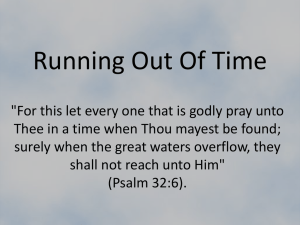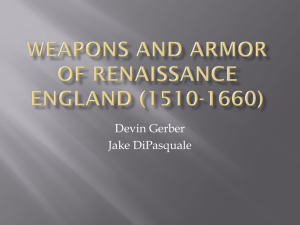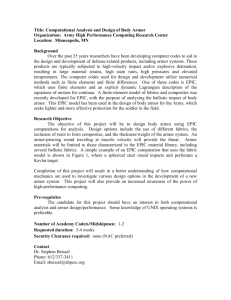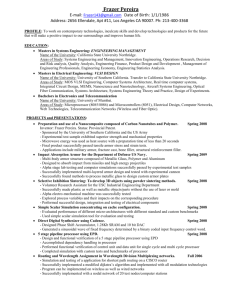Break-even analysis in engineering projects: the case of a
advertisement
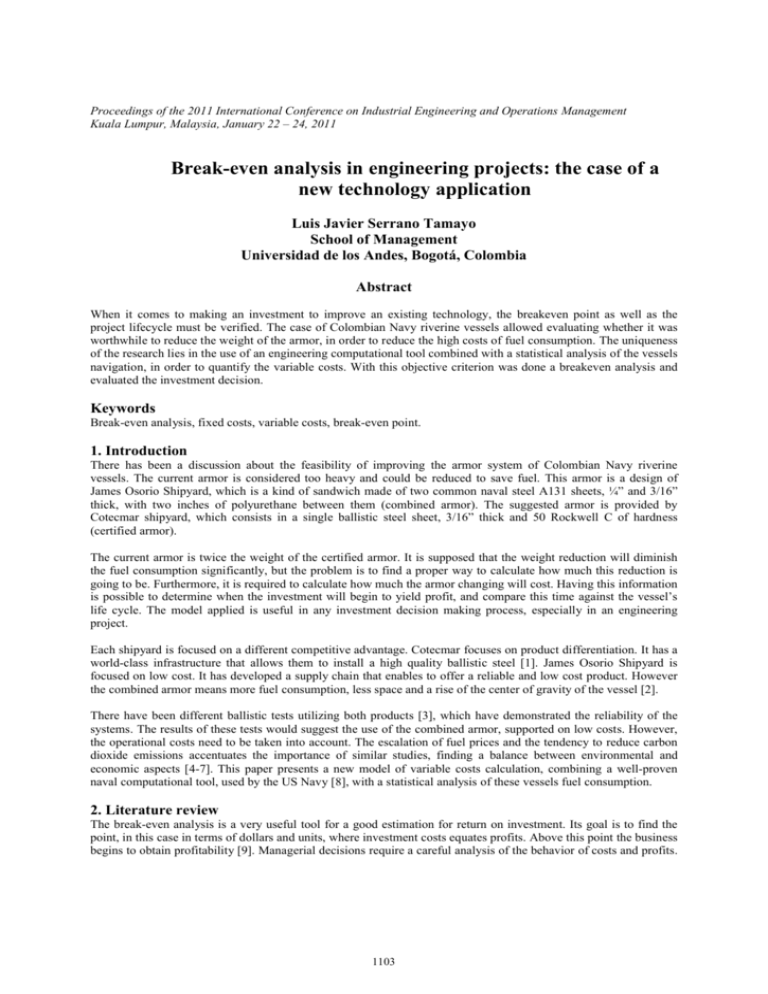
Proceedings of the 2011 International Conference on Industrial Engineering and Operations Management Kuala Lumpur, Malaysia, January 22 – 24, 2011 Break-even analysis in engineering projects: the case of a new technology application Luis Javier Serrano Tamayo School of Management Universidad de los Andes, Bogotá, Colombia Abstract When it comes to making an investment to improve an existing technology, the breakeven point as well as the project lifecycle must be verified. The case of Colombian Navy riverine vessels allowed evaluating whether it was worthwhile to reduce the weight of the armor, in order to reduce the high costs of fuel consumption. The uniqueness of the research lies in the use of an engineering computational tool combined with a statistical analysis of the vessels navigation, in order to quantify the variable costs. With this objective criterion was done a breakeven analysis and evaluated the investment decision. Keywords Break-even analysis, fixed costs, variable costs, break-even point. 1. Introduction There has been a discussion about the feasibility of improving the armor system of Colombian Navy riverine vessels. The current armor is considered too heavy and could be reduced to save fuel. This armor is a design of James Osorio Shipyard, which is a kind of sandwich made of two common naval steel A131 sheets, ¼” and 3/16” thick, with two inches of polyurethane between them (combined armor). The suggested armor is provided by Cotecmar shipyard, which consists in a single ballistic steel sheet, 3/16” thick and 50 Rockwell C of hardness (certified armor). The current armor is twice the weight of the certified armor. It is supposed that the weight reduction will diminish the fuel consumption significantly, but the problem is to find a proper way to calculate how much this reduction is going to be. Furthermore, it is required to calculate how much the armor changing will cost. Having this information is possible to determine when the investment will begin to yield profit, and compare this time against the vessel’s life cycle. The model applied is useful in any investment decision making process, especially in an engineering project. Each shipyard is focused on a different competitive advantage. Cotecmar focuses on product differentiation. It has a world-class infrastructure that allows them to install a high quality ballistic steel [1]. James Osorio Shipyard is focused on low cost. It has developed a supply chain that enables to offer a reliable and low cost product. However the combined armor means more fuel consumption, less space and a rise of the center of gravity of the vessel [2]. There have been different ballistic tests utilizing both products [3], which have demonstrated the reliability of the systems. The results of these tests would suggest the use of the combined armor, supported on low costs. However, the operational costs need to be taken into account. The escalation of fuel prices and the tendency to reduce carbon dioxide emissions accentuates the importance of similar studies, finding a balance between environmental and economic aspects [4-7]. This paper presents a new model of variable costs calculation, combining a well-proven naval computational tool, used by the US Navy [8], with a statistical analysis of these vessels fuel consumption. 2. Literature review The break-even analysis is a very useful tool for a good estimation for return on investment. Its goal is to find the point, in this case in terms of dollars and units, where investment costs equates profits. Above this point the business begins to obtain profitability [9]. Managerial decisions require a careful analysis of the behavior of costs and profits. 1103 In these cases the break-even linear model is widely used. Both revenue and total costs are assumed to be linear in this model, i.e. the price and the variable cost per unit are constants. The uncertainty is considered implicit [10]. Jaedicke and Robichek (1964) introduced uncertainty explicitly into the linear model. This extension of the basic model makes it possible to draw more precise conclusions when the probability distributions are known. Several authors have later extended the theory. However, the extension of the uncertainty inclusion has not reduced the usefulness of the basic linear model itself [10]. The break-even analysis is an economic concept currently used in many fields. As an example, it has been used in health business to optimize the service in orthodontic practice in North Carolina, to predict the future financial potential of pharmacy business in Nebraska, to calculate variable costs of telemedicine consultation in Canada and to evaluate the feasibility and managing daily operations of an ambulatory center in Texas [11-14]. In an engineering project, the break-even analysis was used to decide the optimal distance when the hybrid energy system is more economical than the extension of electric power transmission lines in the north of Turkey. This study pioneered the use of break-even analysis applied to hybrid energy use, furthermore introduced an optimization for defining costs and deciding on the better project option between installing the hybrid energy system or the expansion of the transmission line [15]. Nowadays the break-even analysis is considered one of the most useful analytical tools utilized in real-world business decision making. In some academic fields scientists are trying to add a stochastic linear demand function, which predicts more accurately, but is less suitable for real applications, like the described in the previous references [16]. These studies have shown the usefulness of break-even analysis in engineering projects. For that reason, this tool was selected to determine the best proposal between combined and certified armor, which require the proper estimation of fixed and variable costs discussed below. 3. Methodology of break-even analysis 3.1. Method to decide the best option The method to decide which armor type is the best option encompasses three steps: 1. Establish the difference of installation costs in monetary terms. The vessel studied was a “light riverine patrol vessel” that has previous studies and a deep knowledge of its characteristics, as well as the necessary calculations of weight and fuel consumption [2]. 2. Establish, in terms of time, the break-even point for the installation costs. There are three options: a. Never. b. Short term, armor changing worthwhile. c. Long term, armor changing not worthwhile. Note: This type of vessels has a fifty years life cycle. Nowadays the vessels have twenty years of use. Therefore, from the thirty remaining years, this study established a period of ten years remaining as the criterion for the minimum period acceptable prior to armor changing. 3. Determine the best option based on the results. 3.2. Fixed costs. Fixed costs are defined as those costs that remain constant independent of production [9]. In the study these costs are referred as installation costs of the certified armor instead of the current combined armor. Within these costs underlies an important difference between combined and certified armor, which defines the initial point. A square meter of certified armor installed by Cotecmar weights 37,5 kilograms and costs USD$20 per kilogram installed [2], for a fixed cost of USD$750 per square meter. The same area with combined armor costs USD$350 installed. Considering the complete shielded area in a riverine patrol vessel is 203 square meters [2], the fixed costs result in USD$71.050 for the combined armor and USD$152.250 for the certified armor, a difference of USD$81.200. The weight of the combined armor was calculated as follows: The polyurethane, once mixed and added, has a density of 1.200 kg/m3. Considering the thickness of this layer is 2 inches (51 x 10-3 m), the weight is 61,2 kilograms 1104 per square meter. A naval steel sheet A131, thickness ¼”, 79 Rockwell B hardness [17], has a weight of 50,5 kg/m2. The same sheet, but with a 3/16” thickness has a weight of 37,5 kg/m2. These weights are listed in the table below. Table 1. Specific weights for combined armor Weight of steel ¼” (1 sheet) 50,5 kg/m2 Weight of steel 3/16” (1 sheet) 37,5 kg/m2 Weight of polyurethane (2 inches) 61,2 kg/m2 Overall armor weight 149,2 kg/m2 In the other hand, the certified steel used by Cotecmar, 3/16” ballistic steel, 50 Rockwell C hardness, has a specific weight of 37,5 Kg/m2, i.e., four times less than the combined armor assembly. In a riverine patrol vessel this means that the shielded part using combined armor currently weighing 12 tons, would weigh only 3 tons using certified armor. If the weight of a soldier with his complete equipment is about 130 kilograms, the 9 tons of difference equals to the weight of 70 troops [2]. Likewise, the exchange of the armor type would provide five square meters of additional space for cargo, which in a small vessel could be important space. This could mean that although the installation costs of certified armor are more than twice the combined armor, these costs are offset by the certified security and the remarkable improvement in vessel stability. Likewise, it is noticeable that the use of combined armor causes lower capacity and higher fuel consumption. This fuel consumption is the determining factor for variable costs for break-even analysis. 3.3. Variable costs The variable costs are those that vary according the volume of units produced [9]. In this study, these costs correspond to the hours the ship sails in terms of fuel consumption, which are also known as operational costs. The objective data comes from the analysis of the monthly statistical reports produced by the riverine patrol vessels, allowing the determination of the average fuel consumption. To determine the necessary data required for the projection of 20 years of fuel consumption of a riverine patrol vessel, a three step procedure was established. 1. The statistical information of fuel consumption over the last two years was obtained and used for the projection. 2. Second, a computational tool of naval engineering was used to do the necessary calculation of the fuel consumption for the riverine patrol vessel in terms of gallons per hour. 3. A second run was done using the same software but reducing the nine tons of extra weight, in order to establish the reduction of fuel consumption. 3.3.1. Statistical data The statistical information was obtained for a riverine patrol vessel for two years and is presented in the table. Table 2. Monthly consumption and semiannual average fuel consumption in liters per month Jul-07 6.810 Jan-08 8.857 Jul-08 5.935 Jan-09 967 Aug-07 9.705 Feb-08 3.331 Aug-08 7.304 Feb-09 7.096 Sep-07 4.578 Mar-08 9.265 Sep-08 345 Mar-09 6.677 Oct-07 5.804 Apr-08 8.100 Oct-08 4.335 Apr-09 8.023 Nov-07 3.489 May-08 10.502 Nov-08 5.765 May-09 8.010 Dec-07 809 Jun-08 6.800 Dec-08 3.951 Jun-09 12.605 Average 1 5.183,33 Average 2 7.808,83 Average 3 4.605,83 Average 4 7.231,83 Averaging the information in the table was found that the monthly fuel consumption for a riverine patrol vessel is 6.207,46 liters per month, which is equal to 1.640 gallons per month. Note: The big variations in fuel consumptions between different months are related with the minimum required depth of the river for navigation. 3.3.2. Specialized Software The software NAVCAD is a well-proven computational tool, widely used by universities and institutions related with naval engineering, especially for resistance prediction and power plant design and evaluation [8]. In this paper, 1105 the software was used to calculate the vessel’s fuel consumption, once the vessel’s main characteristics are entered into the program. Since the same software softwa had been used for a previous study of the riverine patrols vessels, this information was available for use [2]. Considering the total weight of the ship is 159,65 tons (full load displacement), using combined armor, the fuel consumption was estimated at 6,25 25 gallons per hour. hour 3.3.3. Second Run Nine tons ns were reduced from full load displacement displacement,, obtaining a new total weight of 150,65 tons. tons Then, the fuel consumption was recalculated, obtaining aining 5,8 5, gallons per hour when en modeling the vessel using certified armor. It must be noticed that a variation of nine tons equates to six percent of the full load displacement of a 150 ton vessel. 4. Results Utilizing the already lready known monthly average fuel consumption of a riverine patrol vessel with the current combined armor, it was possible to obtain a reduction factor from the calculation done for fuel consumption in gallons per hour, when comparing both combined and certified cer armor: Fuel consumption (combined armor): armor 6,25 gph Fuel consumption (certified armor): ): 5,8 5, gph Reduction factor due to certified armor = 5,8 gph / 6,25 gph = 0,928 According to the reduction factor calculated, the monthly fuel consumption using certified ertified armor would be be: 1.640 gph x 0,928 = 1.522 gph. Expressing this in gallons per year would result in 19.680 19 gallons ons per p year with combined armor and 18.624 624 with certified armor. With the information processed in terms of annual fuel consumption is possible to produce a graph in terms of years for the x-axis x axis and thousands of gallons for the yy-axis. However, as the difference must be expressed in monetary terms, data regarding fuel cost must be inserted. The price of a gallon of fuel in the operational operational area of the riverine patrols is about USD$4 per gallon. gallon According to the above and to graph the results in terms of the cost of the product, the difference in installation costs ($81.200) ($81 is divided by the price rice per gallon ($4), yielding a result of 20.300 gallons, which in turn accounts for the initial value of the y-axis axis in the certified armor line when x-axis x axis is zero. With the complete information, the break-analysis break graphics in terms of product costs and fuel consumption could be done. Fig. 3. Break even analysis based on fuel consumption Fig. 4. Break even analysis based on money spent in fuel 5. Discussion The two graphics presented, based on fuel consumption and based on costs spent on fuel, showed that the breakeven point is in fourteen years. This period of time exceeds in four years the ten year minimum criteria adopted in the methodology as the cutoff point, indicating that investing in the change of the combined armor by certified armor is not worthwhile. 1106 There are some additional costs encompassed in the change into new technology that would require other investments, not figured into the costs calculations, like the training required for welders to join commercial steel with armored steel and the losses due to the less cargo capacity of the ship using the combined armor. These costs related above are minor decisions that would be worth if the break-even point would near the limit of ten years established as the decision criterion. In this case it would be necessary to add other minor costs in the equation to make a final decision. 5. Conclusions The new model of variable costs calculation, combining the naval computational tool with the statistical analysis of vessel’s fuel consumption was useful and reliable for break-even analysis. A new technology application can seem favorable and can have advantages over a current one, but the break-even analysis is required to have an objective criterion for decision making investment. The knowledge of the engineering project life-cycle is a critical factor, because it determines the criterion to be evaluated during the break-even analysis. For future research, some questions remain unsolved: How does the end user perceive the differences between the combined and the certified armor? How can this perception be valued? How many man-hours cost does one option weigh against the other? Does using certified armor extend the lifecycle of the vessel and if so should a new time criteria be established? Finally, these questions show that decision making may be increasingly complicated, but using a practical and reliable tool as the break-even analysis, helps decisions to be objectively made based on the most relevant factors. Acknowledgements The author wants to thanks Cotecmar and Colombian Navy for the useful information to do this study. References 1. Nieto, B., Luna, A., Ramos, R., 2010, “A model of technological platform for the knowledge management organization”, WASET International Journal on Science, Engineering and Technology, 63 (1), 399-403. 2. Serrano, J., Carreño, J., 2009, “Stability, propulsion system and rudder evaluation of ARC Manacacías to optimize its operational performance in Meta river”, Proceedings of XXI Pan-American Naval Engineering Conference, 21 (1), 091. 3. Ubeyli, M., Yildirim, O., Ogel, B., 2009, “Effect of hardness on the ballistic impact behavior of highstrength steels against 7.62 mm armor piercing projectiles”, Journal of Materials Engineering and Performance, 18 (2), 145-153. 4. McLean, A., Biles, W., 2008, “A simulation approach to evaluation of operational costs and performance in liner shipping operations”, Proceedings of the 2008 Winter Simulation Conference, 8 (1), 2577-2584. 5. Psaraftis, H., Kontovas, C., 2010, “Balancing the economic and environmental performance of maritime transportation”, Transportation Research. An International Journal, 8 (15D), 458-462. 6. Slager, J., Tomassoni, C., Sanberg, W., 2009, “Energy considerations study on naval ship fuel consumption variations”, Naval Engineers Journal, 93(2), 47-57. 7. Ronen, D., 1982, “The effect of oil price on the optimal speed of ships”, Journal of the Operational Research Society, 33 (1), 1035-1040. 8. Myers, M., Loessberg, A., Clark, D., 2010, “Medium Surface Combatant”, Ocean Engineering Design Report, Virginia Tech University. 9. Heizer, J., Render, B., 2009, “Operations Management”, 9th Edition, Prentice Hall, New Jersey. 10. Norström, C., 1996, “Break-even analysis with nonlinear revenue functions”, Scandinavian Journal of Management, 12(2), 159-163. 11. Murdock, J., Phillips, C., Beane, R., 2010, “Break-even analysis of Medicaid vs. fee for service in orthodontic practice”, American Journal of Orthodontics and Dentofacial orthopedics, 137 (3), 334-339. 12. Keast, S., Jacobs, E., Harrison, D., 2010, “Future economic outlook of Nebraska rural community pharmacies based on break-even analysis of community operational costs and county population”, Research in Social and Administrative Pharmacy, 6 (3), 209-220. 1107 13. Pronovost, A., Peng, P., Kern, R., 2009, “Telemedicine in the management of chronic pain: a cost analysis study”, Canadian Journal of Anesthesia, 56 (8), 590-596. 14. McBryde, M., 2005, “Break-even analysis in a nurse-managed center”, Nursing Economics, 23(1), 31-34. 15. Banu, O., Ozerdem, E., 2009, “Break-even analysis and size optimization of a PV/wind hybrid energy conversion system with battery storage”, 86 (7), 1043-1054. 16. Yunker, J., 2006, “Incorporating stochastic demand into breakeven analysis: a practical guide”, The Engineering Economist, 51 (1), 161-193. 17. Faires, V., 2001, “Design of Machine Elements. Table AT 7: Typical properties of sweet ferrous materials”, 4th Edition, Macmillan Coll Div., New York. 1108

